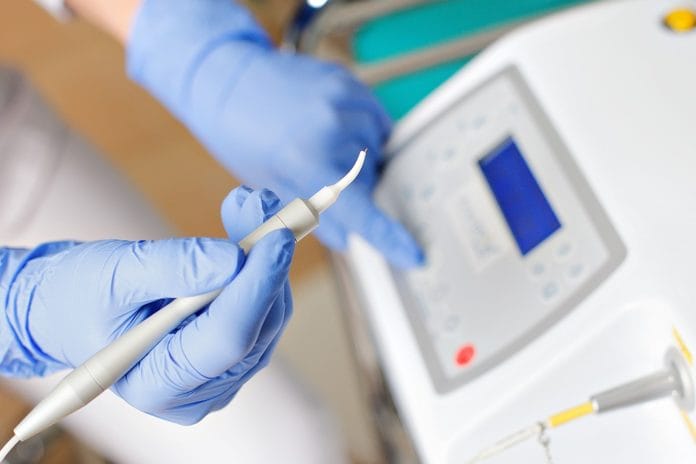Laser dentistry is a non-evasive approach to dentistry. “Laser” is derived from the acronym “Light Amplification by the Stimulated Emission of Radiation.1” Lasers have been used in dentistry for over twenty years for the treatment of both hard and soft tissue.
In 1994, lasers were first introduced in dentistry for soft tissue treatment, after receiving approval from the Food and Drug Administration (FDA).2 Following FDA approval for soft tissue laser treatment, hard tissue (such as bone and mandible) laser treatment, was approved by the FDA in 1996.3 Although laser treatment in dentistry had received FDA approval, the American Dental Association has been hesitant on giving laser treatment “The Seal of Acceptance” until more clinical case studies have been provided.2
There are roughly six types of lasers used in dental laser treatment. Therefore, knowing the type of laser to use typically is determined by the wavelength which is best suited for the treatment needed. The three types of soft tissue lasers are diode laser, carbon dioxide laser, and Nd:YAG Laser. The diode laser is the most commonly used laser in dental treatment. The remaining three lasers which can treat soft or hard tissue, are the Er:YAG laser, carbon dioxide laser and Er,Cr:YSGG Laser.3
The soft tissue lasers are best suited for removal of excess gum tissue, removal of bacteria, for biopsy or lesion removal, and manipulation of tissue to prevent snoring. Soft tissue laser treatment results in less bleeding, less swelling, and possibly no anesthetic needed due to the decrease of pain during laser treatment.
Hard tissue lasers remove decay and prepare the tooth for a restoration, and can also be used as an activator during whitening treatment. However, a dental handpiece may still be needed during hard tissue laser treatment to shape the tooth, adjust the bite, or polish the restoration. There are also limitations with hard tissue laser treatments limiting the type of restoration which can be performed. Subsequently, hard tissue lasers cannot treat teeth with existing restorations, decay located interproximally, or in preparation for bridges or crowns. Furthermore, the use of a dental laser does not guarantee the elimination of anesthesia during dental treatment.
More recently, laser dentistry has been introduced to the dental hygiene community. Laser therapy performed by a dental hygienist includes non-surgical periodontal treatment of the sulcus/bacterial reduction, aphthous ulcer removal, and pit-fissure sealants. Non-surgical periodontal treatment involves the curettage of the intra-sulcular pocket to remove diseased tissue and decrease the bacterial load. Scaling and root planing with a laser is a benefit in removing hard deposits on the root surface with minimal bleeding, and it decreases the stress placed on the clinician in hand instrumentation.
The removal of aphthous ulcers by laser is far superior to medication because it promotes healing much faster and more effectively, reduces pain immediately, and decreases the risk of recurrence. A study conducted by the University of Louisville reported that 50% of patients undergoing laser removal of aphthous ulcers had no recurrence within six months, and an astounding 63% reported faster healing.4 In a study conducted on pit and fissure application methods, laser treatment to the tooth surface prior to etch and sealant placement was the most effective method with the least amount of micro-leakage.5
The Academy of Laser Dentistry has outlined a curriculum of standards in education with the use of dental lasers.6 The scope of practice for dental laser use includes demonstration, safety, and hands-on education to assure proficiency in dental laser use in the practice setting. At the completion of the course, a certificate is issued to the clinician with future advanced courses available to elevate the clinician’s education in dental lasers.
As dental treatment evolves, it is important for dental clinicians to stay up-to-date and mindful of elevated treatment options to ensure the highest standard of care to the patient. Dental lasers are beneficial to treatment in soft and hard tissue but do pose the disadvantage of being time-consuming and requiring additional education. However, with only eighteen states not participating in the use of dental lasers for the dental hygienist, the benefits may outweigh the disadvantages to stay competitive in the current dental market.
Need CE? Click Here to Check Out the Self-Study CE Courses from Today’s RDH!
Listen to the Today’s RDH Dental Hygiene Podcast Below:
References
- Verma, S.K., Maheshwari, S., Singh, R.K., Chaudhari, P.K. (2012). Laser in dentistry: An innovative tool in Modern dental practice. National Journal of Maxillofacial Surgery. Jul-Dec; 3(2): 124-132. Retrieved from https://www.ncbi.nlm.nih.gov/pmc/articles/PMC3700144/
- Laser Use in Dentistry. (2018). Web MD. Retrieved from https://www.webmd.com/oral-health/guide/laser-use-dentistry
- Dental Laser. Wikipedia. Retrieved from https://en.wikipedia.org/wiki/Dental_laser
- Laser Treatment for Canker Sores. My Canker Sore Treatment. Retrieved from https://www.mycankersoretreatment.com/laser-treatment-for-canker-sores/
- Topaloglu-Ak, A., Oncag, O., Gokce, B., Bent, B. (2013). The effect of different enamel surface treatments on microleakage of fissure sealants. Acta Medica Academica. 2013 Nov:42(2):223-228. Retrieved from https://www.pubfacts.com/detail/24308402/The-effect-of-different-enamel-surface-treatments-on-microleakage-of-fissure-sealants
- Curriculum Guidelines. (2019). Academy of Laser Dentistry. Retrieved from https://www.laserdentistry.org/index.cfm/members/Curriculum%20Guidelines












